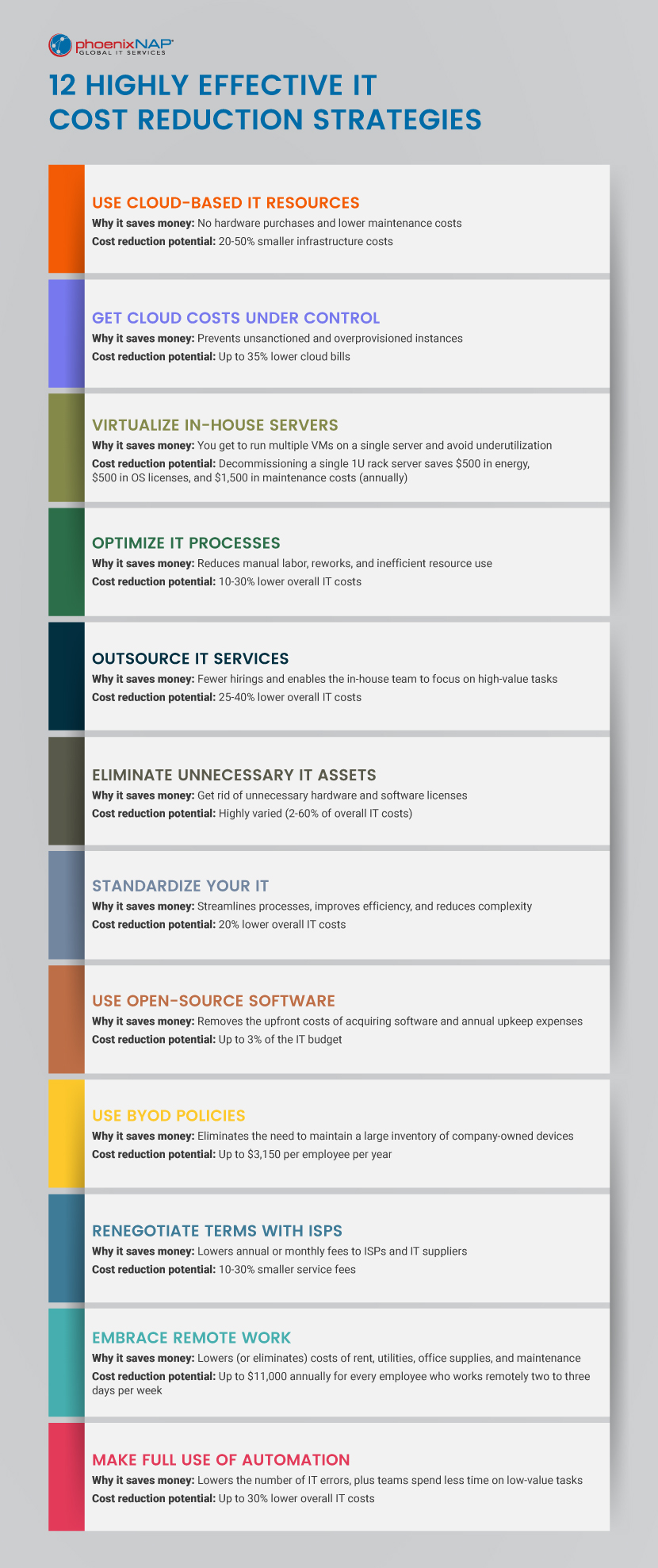IT cost reduction (also known as IT cost optimization) is the process of eliminating sources of waste and low value in IT departments. Some of these strategies have a near-instant effect on the budget, while others positively impact your bottom line in the mid-to-long run.
However, all cost reductions require careful planning to avoid becoming counterproductive. Overly radical cost-saving decisions damage business health and employee morale, so it's vital you know what you're doing when cutting down IT costs.
This article presents 12 tried-and-tested IT cost reduction strategies that lower expenses and boost the cost-effectiveness of your IT. Read on to see how CIOs and CFOs reduce costs without resorting to employee layoffs or causing long-term turmoil.

IT Cost Reduction Strategies
On average, companies worldwide spend 7.5% of their revenue on IT (organizations in the US allocate approx. 8.5% of revenue to IT, while companies in the EU keep that figure around 6%).
Now that you know the ballpark of where your tech expenses should be, let's see what IT cost reduction strategies help reach an optimal spend-to-revenue balance.

1. Go All-In on Cloud Computing
Replace some (if not all) of your on-site infrastructure with cloud-based resources. Such a move reduces or eliminates most expenses associated with on-prem hosting.
Here are the main reasons why adopting the cloud is so cost-beneficial:
- Reduced infrastructure costs. Moving to the cloud removes the need for on-prem hardware (servers, networking equipment, storage devices, etc.). You eliminate upfront capital expenses and reduce the operational costs of your infrastructure.
- Cost-effective pricing. Cloud providers charge based on a pay-as-you-go pricing model, so you only pay for the resources your team actually uses. You scale up or down based on current needs to avoid overprovisioning, so there's never unused excess capacity.
- Little to no in-house maintenance. Once you start using the cloud, you no longer spend time and money on hardware maintenance (monitoring, patching, replacing components, etc.). You also reduce on-site energy consumption, which further drives down costs.
If moving everything to the cloud is not an option, a hybrid cloud environment also has massive cost-saving potential. A hybrid architecture enables you to integrate public and private hosting environments to create the most cost-optimal setting for your apps and workloads.
Our comparison of on-prem and cloud computing helps determine whether on-demand IT resources are a good fit with your business needs and priorities.
2. Get Cloud Costs Under Control
Recent studies reveal that an average company wastes about 35% of its total cloud spend. There are a few common causes of unnecessarily high cloud costs:
- Less experienced or careless team members over-provisioning cloud instances.
- Teams using unsanctioned cloud resources without the IT department’s knowledge or approval.
- No go-to staff members responsible for monitoring the total cloud spend.
- Employees who spin up resources and forget to release them once they reach EOL.
Improve the visibility of your cloud spending to reduce IT expenses. Use a cloud cost management tool that enables you to:
- Centralize cloud cost management.
- Identify and delete unused, unsanctioned, and overprovisioned instances.
- Forecast future expenses.
- Gain insights into cloud usage.
Refer to our article on cloud computing costs to learn more about effective cloud bill management.
3. Virtualize In-House Servers
Virtualizing servers is an excellent IT cost reduction strategy, enabling you to run multiple virtual servers on a single physical machine you already own. Sharing physical server resources among multiple virtual machines (VMs) avoids underutilized servers and helps save costs on:
- Hardware acquisition.
- Day-to-day maintenance.
- Power consumption and cooling.
Remember that a single 1U rack server annually costs $500 in energy, $500 in OS licenses, and $1,500 in maintenance expenses. Virtualization reduces the number of required on-site servers, so you can either retire or sell some of your hardware. You also save money by reducing space requirements in your server room, which lowers facility costs.
Check out our article on Virtual Data Centers (VDCs) and see how the virtualization strategy extends to an entire server room.
4. IT Process Optimization
Look for opportunities to improve the efficiency and reliability of IT processes within your organization. Streamlining and optimizing processes enhances productivity and reduces error rates, two key factors in IT spending.
Here are a few examples of what IT processes you can improve:
- Reporting and resolving IT incidents (e.g., you could add a centralized ticketing system or define better escalation procedures).
- Requesting, approving, and making changes to IT systems (e.g., you could define clear change policies or implement a centralized management system).
- Handling common user requests, such as software installations or account provisioning (e.g., you could create a knowledge base with FAQ or develop a self-service portal).
- Workflows in your Software Development Life Cycle (SDLC) pipeline (e.g., you could adopt CI/CD, automated testing, or a better version control system).
Improving IT processes lowers expenses by reducing manual labor and the number of reworks the team must perform. You also enhance the quality and consistency of IT services, so there's less chance of costly downtime and disruptions.
5. Outsource IT Services
Consider outsourcing time-consuming IT tasks to external service providers or freelancers. This strategy reduces long-term costs by:
- Removing the need to hire new full-time employees or train existing ones.
- Enabling the in-house team to focus on revenue generation and core business functions.
- Reducing overhead expenses (e.g., additional office space, equipment, utilities, employee benefits, etc.).
Here are a few must-know stats about outsourcing IT staff:
- Companies experience IT cost reductions of 25-40% by outsourcing services.
- Around 56% of companies with 100 or more employees cite improved efficiency as the main driving factor for outsourcing.
- Over 78% of small businesses use freelance services to manage some aspect of their IT.
Some of the most common responsibilities companies outsource to a third-party team are:
- Help desk duties.
- Network management.
- Cybersecurity management.
- Infrastructure maintenance.
- Software development.
Check out our managed services for bare metal and cloud platforms to learn more about the benefits of outsourcing day-to-day infrastructure management.
6. Eliminate Unnecessary IT Assets
The fastest way to reduce IT costs is to eliminate unnecessary assets. Analyze your entire IT landscape and identify assets that are:
- Underutilized.
- Outdated.
- Redundant.
- No longer aligned with business needs.
Here are a few examples of assets you can eliminate:
- Application licenses. Software licenses for on-prem and SaaS software are typically among a company's biggest expenses. Remove overlapping and unnecessary licenses to slim down the costs of your app portfolio.
- Services and subscriptions. Identify and eliminate unnecessary services, such as unsanctioned IaaS instances or hosting of outdated web pages.
- Infrastructure assets. Repurpose or sell all unnecessary hardware (servers, laptops, communication systems, printers, etc.) to avoid costs associated with maintenance, support, and upgrades.
- IT projects. Review and prioritize planned and upcoming projects for value and urgency. Eliminate all low-value projects and focus the team on tasks that bring immediate value.
Asset analysis also presents an excellent opportunity to assess whether there are cheaper or more cost-effective alternatives available on the market.
An example of budget-friendly asset removal is to switch an old on-site server that keeps breaking down with one of our Bare Metal Cloud (BMC) servers.
You lower day-to-day expenses, obtain a cheaper hosting solution (you can get a BMC for as low as $0.08/h), and get a highly scalable server that lets you control your spending.
7. Standardize Your IT
Standardization reduces IT costs by improving overall efficiency and reducing complexity. Here are the areas of your IT worth standardizing:
- Hardware. Standardize hardware (e.g., desktops, laptops, servers, networking equipment, etc.) to simplify procurement and support processes. Standardized infrastructure also leads to better scalability and compatibility.
- OSes and software. Standardizing operating systems and applications simplifies deployment, patch management, and user support.
- IT policies. Set standardized policies (for data backups, password management, software usage, cloud security, etc.) to boost consistency across the organization. Clear and standardized guidelines reduce the risk of errors and inefficiencies that lead to additional costs.
- Configurations. Standardizing network configurations (e.g., network protocols, IP addressing schemes, naming conventions, etc.) simplifies management and troubleshooting.
- Documentation. Standardize all documentation and knowledge platforms to reduce the time and effort required for info sharing and onboarding new team members.
Standardization also helps counter the risk of shadow IT (the use of unauthorized devices and apps), one of the most common causes of security vulnerabilities and high IT costs.

8. Use Open-Source Software
Instruct your team to use open-source software whenever possible to avoid the upfront costs of acquiring software and annual upkeep expenses. Recent reports indicate that companies can save up to 3% of their IT budget by transitioning from commercial to open-source apps.
In addition to avoiding the high costs of software licenses, open-source tools typically have active communities. These communities provide free support for:
- Ongoing updates.
- Bug fixes.
- Security patches.
Open-source software also grants access to the source code. If your team has the necessary know-how, it's possible to customize the app to suit your business needs and further boost cost-effectiveness.
9. Use BYOD to Drive Down Costs
Bring Your Own Device (BYOD) is a policy that enables employees to use personal devices for work-related activities.
Recent studies reveal that companies save up to $3,150 per employee per year with BYOD. BYOD leads to such a high IT cost reduction due to the following reasons:
- Hardware cost savings. BYOD eliminates the need to purchase and maintain a large inventory of company-owned devices. As a result, there are significant cost savings on hardware acquisition and replacement.
- Less device management. BYOD means employees are responsible for their work devices. There's reduced device management overhead as the IT department is no longer responsible for software updates and troubleshooting.
- Lower maintenance costs. By placing the burden of BYOD device repairs on owners or manufacturers, you can lower IT support costs.
In addition to these cost savings, BYOD also boosts employee productivity. People tend to be more comfortable and familiar with their own devices, which often leads to efficiency gains.
Our article on BYOD policies explains how to seamlessly and safely implement BYOD strategies in your organization.
10. Renegotiate Terms with Service Providers
Renegotiating contracts with ISPs, suppliers, and other service providers is another effective IT cost reduction strategy. Renegotiating contracts with providers enables companies to reduce current fees by 10 to 30% on average.
Always perform a market analysis before you start renegotiations. Explore alternatives and compare offerings from different ISPs, suppliers, and service providers. Use these proposals to get insights into current market rates and leverage them during negotiations to secure more favorable pricing.
Renegotiating contracts is also an excellent opportunity to review and update the service level agreements (SLAs) with your providers. Align service levels with business requirements and further reduce costs in the long run.
11. Embrace Remote Work
Enabling your team to work remotely has several cost-saving benefits, such as:
- Reduced office space. Remote work reduces the need for office spaces. You spend less on rent, utilities, office supplies, maintenance, etc.
- Infrastructure savings. Remote employees use their own devices and internet connections, reducing the need for the company to provide costly hardware and networking infrastructure.
- No commuting costs. Remote work eliminates commuting expenses for your employees.
- Morale boost. Offering remote work increases employee satisfaction, so expect better retention rates. High retention also reduces recruitment and training costs associated with a high turnover rate.
Recent research suggests companies save up to $11,000 for every employee who starts working remotely two to three days per week. This high figure results from reduced rent costs, increased productivity, and lower employee turnover rates.
Remote work is highly cost-beneficial, but such a strategy introduces new risks to a workplace. Learn how to provide secure remote access for employees and ensure WFH policies do not cause security vulnerabilities.
12. Make Full Use of Automation
Automating repetitive, time-consuming, and error-prone processes is an excellent IT cost reduction strategy for several reasons:
- The team stops focusing on low-value tasks and commits to more valuable activities.
- You eliminate bottlenecks, reduce dependencies on specific employees, and ensure consistent execution of tasks.
- Automation enables you to accomplish tasks faster and with fewer resources.
- You reduce the likelihood of errors that lead to costly mistakes or unnecessary reworks.
Recent surveys reveal that 59% of companies that embraced automation report IT cost reductions of up to 30%. Here are some examples of processes worth automating to reduce the day-to-day costs of your IT:
- Infrastructure deployments and configuration.
- Creation, modification, and removal of user accounts and access privileges.
- Backup and recovery processes (scheduling regular backups, verifying data integrity, recovering files in the event of data loss or system failures, etc.).
- Monitoring of infrastructure, apps, and network devices.
- Patching and updating of apps and OSes.
- Responding to server downtime, high resource utilization, or security breaches.
- Logging, routing, and tracking of IT incidents and problems.
- Password resets.
- Provisioning and managing test environments (creating and replicating environments, deploying test data, automating the deployment of test apps, etc.).
- Generation and distribution of reports and analytics.
Check out our articles on test automation frameworks and auto-testing tools if you want to eliminate time-consuming manual testing.

Use IT Cost Reduction Strategies to Reduce Expenses and Improve Your Bottom Line
Some strategies listed above have a near-instant effect on the budget and yield quick wins. Others require some time to make an impact. Use this article to assess which IT cost reduction strategies make the most sense for your company and start lowering IT expenses to free up more funds for business development, revenue generation, and innovation.



